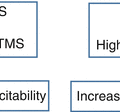Fig. 33.1
The differential preservation hypothesis of cognitive performance across ages (left)—by which the level of cognitive performance late in life depends on the level of cognitive performance during adulthood—and preserved differentiation hypothesis (right), by which difference in performance during adulthood is preserved (From Salthouse [9])
Based on these premises, in the next section, we will briefly review three neurobehavioral approaches typically used to improve cognitive functioning in normal aging, namely, strategy training, processing training, and multitasking training, focusing on what extent they are appropriate to induce neuroplasticity with positive consequences in the aged brain.
33.2 Neurobehavioral Training Methods
33.2.1 Strategy Training
To increase performance in tasks that older adults perform inefficiently, strategy training methods are typically used. Strategy methods have been used to improve memory, reasoning, and executive functions, a set of cognitive processes that are necessary for the cognitive control of behavior (for a review [10]).
Strategy training is typically used to improve memory functions. The protocol involves instructions relative to one or more internal mnemonic strategies to be employed in the recall task. These involve mentally visualizing landmarks along a well-known route (method of loci), organizing information into meaningful categories, forming visual images and mental associations between the item to remember and faces, numbers, or objects (pegword). A seminal meta-analysis [11] revealed a positive effect of mnemonic strategies that ranged between small Cohen’s d effect sizes (mean difference between the training and control group divided by the pooled standard deviation) for imagery (d = 0.14), moderate for pegword (d = 0.5), and larger (d ≥ 0.8) for the method of loci, the name-face, and the organization strategies. A following large-scale study involving 2832 participants aged 65–94 years [12] confirmed that strategy-based and speed of processing training resulted in reliable cognitive improvement; in addition, the effects of cognitive training were maintained after 2 years and transferred to cognitive demanding everyday functioning. The general outcome from these studies [13, 14] is that the benefit of training with laboratory-based memory tasks is significant, although task specific.
Strategy training methods have also been used for improving reasoning or executive functions in elderly. Boron et al. [15] used inductive reasoning training tasks in which participants were required to recognize novel pattern rules and to use them to solve similar problems. A control group was trained with a spatial orientation task, regarding the ability to mentally rotate figures. The reasoning training group showed significantly greater gain in accuracy with respect to the spatial orientation group, independently of the speed of responding. Furthermore, Levine et al. [16] trained goal management strategies involving the identification of high-risk situations, stopping “automatic pilot” behavior, and breaking down goals into sub-goals and found an improvement mainly regarding subjective reports.
Overall, these “strategy training” protocols are instrumental for the improvement in specific and laboratory-based tasks, but they do not appear successful in generally improving memory, reasoning, and executive functions. Furthermore, the requirements of specificity and endurance to infer neuroplasticity are met, but that of transfer to untrained cognitive domains is not.
33.2.2 Processing Training
These protocols involve training on tasks mediated by a particular process and assessment of post-training improved efficiency on untrained stimuli and tasks engaging the same process. The goal of processing training is to obtain transfer of training to different tasks that individuals perform outside the laboratory setting. Indeed, while task-specific improvement in laboratory tasks has been well documented, the clinically relevant question of whether laboratory training improvement can transfer to tasks that older adults perform outside the laboratory has been less researched.
One goal of processing training is to reduce the age-dependent deficit in intracortical inhibition, possibly associated to alterations in GABA-mediated inhibition [17]. Wilkinson and Yang [18] addressed the issue of whether “inhibition training” had positive consequences on inhibitory behavior. They examined the inhibition retest learning in older adults using a color-word Stroop retest training paradigm and showed that training reduced the interference effects. Most importantly, the improvement was not item specific although it did not transfer to other tasks. These results suggest that the well-reported age-dependent inhibitory deficits are reversible and can be modified in older age.
Another aspect of sensory and cognitive processing that may have a broad effect on cognitive functions is speed of processing. Both human and animal studies reveal that age-dependent reduction in processing speed results from inefficient neuromodulation. In particular the reduction in dopamine receptors has been shown to have a key role in slowing down speed of processing [5]. In humans, aging-related reduction of dopamine receptors D2 [19] has been shown to result in decline of processing speed in word and face recognition. The relationship between speed of processing and cognitive efficiency is well described by Salthouse [20], according to whom the reduction of speed of processing with age may affect the speed with which many cognitive operations can be executed and this cause can be primary with respect to other relevant causes such as working memory [21]. Evidence for transfer effects of training in perceptual speed tasks comes from Salthouse and Tucker-Drob [22], indicating that test-retest effects in perceptual speed remained substantially equivalent between tasks using different items with respect to tasks using similar items. Considering the strong connection between the cognitive processing speed abilities and everyday performance (driving, mobility, gait, functional reach, risk for falling), training speed of processing may have the potential to improve everyday life among older adults.
In addition to inhibitory and speed processing, other basic processes have been trained with positive outcomes on transfer tasks. For example, training-dependent improvement in single and dual tasks of attention, working memory, and manual control, which involve relatively low-level cognitive processes, is predictive of improvement in unrelated tasks, such as driving in older adults [23]. These results are particularly important when considering that the trained tasks, in particular attention and motor ones, are significant factors (together with those involving perceptual, executive functions) in accounting for driving performance [23]. From these results, it can be suggested that transfer of training-dependent improvement from a laboratory setting to real-world task performance relies on the improved capability of distributing attention among concurrently performed skills.
Even the improved capability of shifting processing priorities seems relevant in inducing transfer. For example, effects of transfer in training executive functions, as probed by improvement in the capability of task switching, have been found: practicing in a variety of dual-task switching tasks improved the ability to switch between unpracticed pairs of near tasks in older age [24]. This result is important because daily life, such as reading newspaper or cooking a meal, often demands mental flexibility in shifting between different tasks.
Despite the evidence that processing training has good generalization potential, more often strong specificity has been reported. One potential problem of these training paradigms, which may prevent generalization to tasks normally performed in day-to-day life, is that they focus on single-task training.
33.2.3 Multitasking Training
A promising alternative in the field of training regimes to improve cognitive abilities is provided by multitasking training. Multitasking, which involves cognitive control, i.e., the capability of developing different action control and/or filtering out interference from irrelevant tasks, is reduced by aging. One measure of multitasking ability is to involve participants in performing two tasks in isolation and together [25]. It has been suggested that a less controlled multitasking training protocol, with a custom-designed 3-D video game (NeuroRacer), may lead to reduced multitasking costs in older adults [26]. After training, the older group performance improved to, and beyond, the level of the untrained younger group. The improvement was retained at 6 months follow-up. Most importantly the effect of training transferred to untrained cognitive control abilities (enhanced sustained attention and working memory), suggesting that these training protocols may enhance the ability to learn new tasks. Both the trained and the transfer behavioral effects of training were associated to a modulation of the neural mechanism underlying cognitive control, i.e., increased in midline frontal theta power, as assessed by electrophysiology. These results highlight the vigorous plasticity of the prefrontal cognitive system in the aging brain. However, how exactly neural responses to constituent tasks adapt with training remains to be characterized. One speculative hypothesis is that multitasking learning allows task representations to become more distinct after training.
33.3 New Directions in the Field of Plasticity in Aging
Phenomena of plasticity in the aging brain representing flexible recruitment of brain areas and reflecting structural and functional changes (either substitutive or in response to restorative learning and experience) have been highlighted by functional magnetic resonance imaging (fMRI).
Modulation of neural activity is necessary in order to show a causative relation between neural activation and plasticity. There are two safe and noninvasive methods to manipulate neural activity: repetitive transcranial magnetic stimulation (rTMS) and transcranial direct current stimulation (tDCS). rTMS is obtained by applying brief electrical pulses via a coil to a specific brain region; depending on the pulse arrangement, rTMS activates or inhibits neural activity under the coil and may also enhance or inhibit regions whose activity interferes with task performance. tDCS operates by applying a small amount of current through two electrodes attached to the scalp. TMS and tDCS modulation of specific brain regions may increase speed and accuracy in activities based on attention, perception, and memory [27]. Indeed, one week of object location learning with anodal tDCS applied over the temporoparietal cortex led to a large increased of memory performance compared to the sham control group that learned without anodal tDCS [28]. Moreover, older adults’ performance in complex motor skill tasks was enhanced by tDCS applied to the motor cortex [29]. Importantly, anodal tDCS over right but not left dorsolateral prefrontal cortex increased the proportion of performance errors that were consciously detected, indicating that this area is involved in error awareness and that tDCS may restore the weakness that older adults present in this function. Meinzer et al. [30] used fMRI to investigate neurofunctional correlates of a tDCS-induced modulation of performance in a semantic word generation task. tDCS significantly improved performance in older adults up to the level of younger controls and significantly reduced task-related hyperactivity in bilateral prefrontal cortices, the anterior cingulate gyrus, and the precuneus.
Stay updated, free articles. Join our Telegram channel

Full access? Get Clinical Tree





